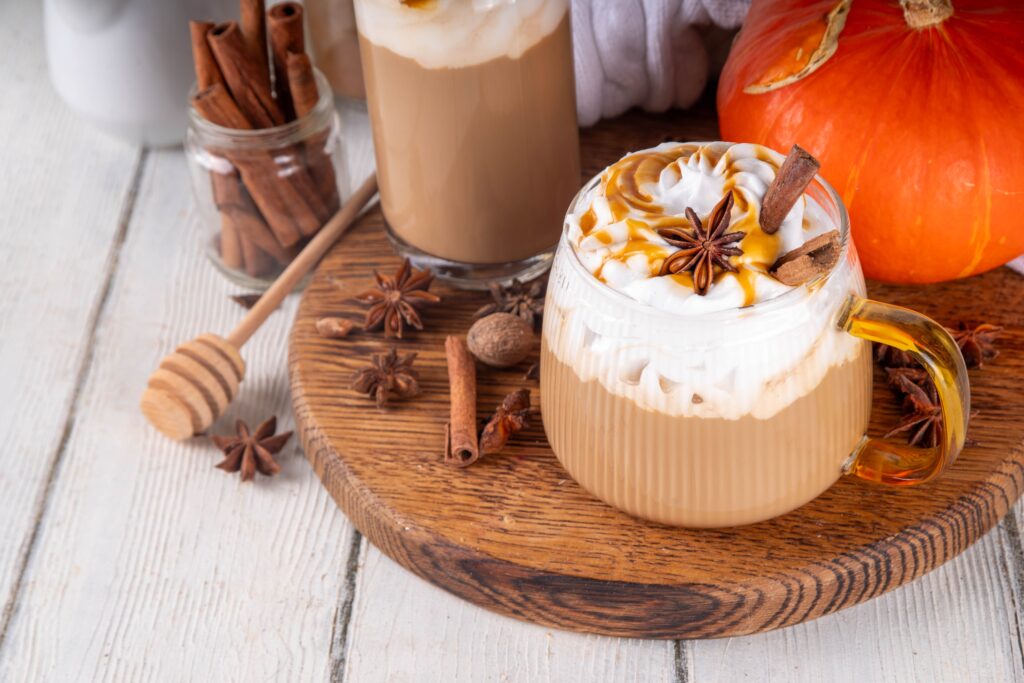How to Make an IBS-Friendly Pumpkin Spiced Latte
- Low FODMAP Recipes
Pumpkin spiced lattes are the ultimate autumn drink — cozy, warming, and full of seasonal flavour. But if you have Irritable Bowel Syndrome (IBS), you might be wondering: is pumpkin spiced latte low FODMAP and safe for people with IBS?
As a dietitian working with IBS every day, I find that many of my clients are nervous about seasonal drinks and coffee shop specials. The good news is that with a few simple swaps, pumpkin spiced lattes can be enjoyed safely without triggering IBS symptoms.
In this post, I’ll show you how to make an IBS friendly pumpkin spiced latte at home and how to adapt your order when you’re out.

Is Pumpkin Spice Latte Low FODMAP and Safe for People with IBS?
Here’s what I see in practice:
- Pumpkin is low FODMAP in moderate amounts — about 2 tablespoons of canned pumpkin puree is usually tolerated well. I find that when my clients stick to this amount, they enjoy the flavour without problems.
- Pumpkin spice isn’t just delicious; it also contains prebiotics that help feed your gut microbes. Many of my clients are pleasantly surprised that their favourite autumn spice mix can actually be good for gut health.
- Milk choice matters: regular milk contains lactose, which is a common trigger. I recommend using low FODMAP milk such as almond or lactose-free milk as the best swaps. Oat milk is high FODMAP and can cause issues, so I don’t advise using it.
- Coffee itself can be an issue because caffeine speeds up gut motility. I find that switching to decaf coffee often makes these drinks much more tolerable for my clients.
- Whipped cream doesn’t need to be avoided — Monash University has shown it’s low FODMAP in portions up to 200g (around 2 cups). Many of my clients are delighted to hear they don’t have to give up that indulgent topping.
- Sweetness: cafés often use condensed milk, which is high in lactose. When my clients swap to almond or lactose-free milk, they sometimes find the drink isn’t as sweet. In this case, I suggest adding a little white sugar, which is easily digested and safe on a low FODMAP diet.
Do You Need to Avoid Cream with IBS?
Many people with IBS automatically think they need to avoid cream because of its lactose content. Lactose intolerance is indeed common in IBS, and high-lactose foods can sometimes trigger bloating, pain, and diarrhoea.
However, cream is actually lower in lactose compared to milk. According to Monash University, you can enjoy up to 200g of cream in one serving and still remain within the low FODMAP range.
I find that my clients are often relieved to hear this — it means you don’t have to miss out on that indulgent finishing touch. If you love the creamy topping, you can keep it on your latte without worrying about flaring your IBS.
IBS-Friendly Pumpkin Spiced Latte Recipe
Serves 1
Ingredients:
- ¾ cup lactose-free milk or almond milk
- 2 tbsp canned pumpkin puree (not pumpkin pie filling)
- ½ tsp pumpkin spice mix (or a pinch each of cinnamon, nutmeg, and ginger)
- 1 tsp white sugar
- ½ tsp vanilla extract
- 1 shot of decaf espresso (or ½ cup strong decaf coffee)
- Whipped cream (optional, but safe for IBS)
Method:
- In a small saucepan, whisk together the milk, pumpkin puree, pumpkin spice, sugar, and vanilla.
- Heat gently over medium heat until steaming (don’t boil).
- Froth using a milk frother or whisk until foamy.
- Pour the decaf espresso into a mug, then top with the pumpkin milk mixture.
- Add whipped cream and a dusting of cinnamon if you like.
Tip: I find that my clients do best when they keep pumpkin puree to 2 tablespoons per latte. It’s enough for flavour, while still being gentle on digestion.
IBS-Friendly Tips for Ordering Pumpkin Spice Lattes When Out
If you’re grabbing a pumpkin spiced latte from a café, you don’t have to miss out. I find that my clients do really well when they use the following swaps and tweaks:
- Choose almond milk or lactose-free milk where available, instead of regular milk. Oat milk is high FODMAP, so I don’t recommend it.
- Go decaf — caffeine is a common gut stimulant, and my clients often notice fewer symptoms when they make this switch.
- Keep the whipped cream if you like it — it’s actually low FODMAP in portions up to 200g.
- Use regular sugar for sweetness if the drink tastes less sweet without condensed milk. Sugar itself is not a trigger for IBS.
- Avoid sugar-free syrups — these often contain sugar alcohols (polyols), which can cause bloating, gas, and diarrhoea in some people with IBS.
- Stick to a small size — this naturally limits caffeine, sugar, and portion size, which many of my clients find makes it easier on their digestion.
Final Thoughts
So, is pumpkin spiced latte safe for people with IBS? From my experience, yes — with the right tweaks. I find that my clients do well when they use almond or lactose-free milk, opt for decaf coffee, keep pumpkin portions moderate, and enjoy whipped cream if they want it.
That way, they can enjoy the flavours of autumn without worrying about IBS flare-ups. Whether you make it at home or adapt your order when out, you don’t have to miss out on pumpkin spice season.